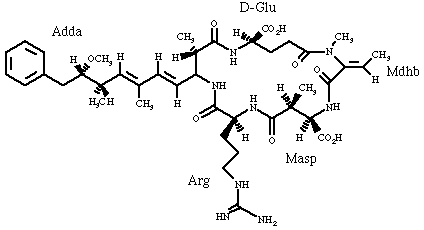
This page and its links are still under construction.
The first scientific report of the potent toxicity of cyanobacterial blooms was made in Nature by Francis in 1878. The author reported that stock deaths had occurred as a result of drinking from a bloom infested lake in Australia. The organism resposible for this bloom was later described as Nodularia spumigena and the toxin has since been isolated and characterised (Rinehart et al. , 1988) as Nodularin.
The structure of nodularin is related to the potent cyclic heptapeptide
hepatotoxins, the microcystins, but differs in that
nodularin is composed of only five amino acids in the peptide ring. Not only
are the stucture of these two cyanobacterial toxins similar, but they both show
the same hepatotoxic effect through the potent inhibition of protein phosphatases and similar
IC50 and
LD50 values.
